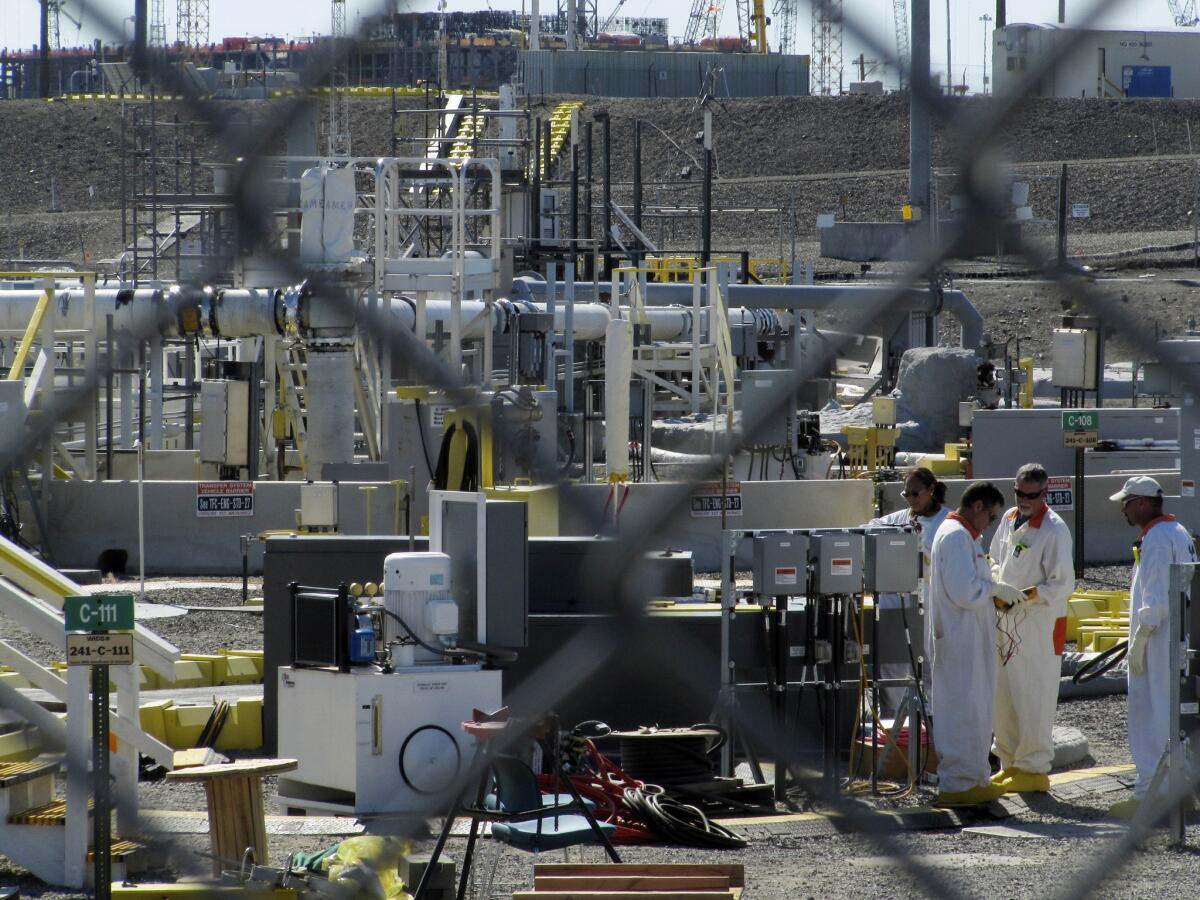Hanford nuclear weapons site whistle-blower wins $4.1-million settlement

Workers at the Hanford nuclear site in Washington state.
- Share via
When Walter Tamosaitis warned in 2011 that the Energy Department’s plans for a waste treatment plant at the former Hanford nuclear weapons complex were unsafe, he was demoted and put in a basement room with cardboard boxes and plywood for office furniture.
Tamosaitis had been leading a team of 100 scientists and engineers in designing a way to immobilize millions of gallons of highly toxic nuclear sludge as thick as peanut butter. The sludge, which could deliver a lethal dose of radiation to a nearby person within minutes, is stored in leaking underground tanks near the Columbia River in Washington state.
Two years later, Tamosaitis was fired after 44 years with San Francisco-based engineering firm URS, which was later acquired by Los Angeles-based AECOM. He filed a wrongful termination suit but encountered some initial legal setbacks, and it looked as if he had been blackballed from the industry.
But on Wednesday, Tamosaitis won a $4.1-million settlement from AECOM, among the largest known legal damages paid out to a whistle-blower in the Energy Department’s vast nuclear waste cleanup program.
“It was something I lived with every minute of every day over the last five years,” Tamosaitis, 68, said in an interview. “Hopefully, I have sent a message to young engineers to keep their honesty, integrity and courage intact.”
AECOM spokesman Ed Mayer said the company reached its resolution with Tamosaitis “in order to avoid the cost and distraction of litigation relating to events that occurred over five years ago. The company strongly disagrees that it retaliated against him in any manner.”
Mayer added that safety is the company’s top priority and that it encourages “a questioning attitude.”
Tamosaitis led the research into the complex technology of transforming the toxic and radioactive sludge into solid glass that could theoretically be buried safely for thousands of years. The work is to be performed at a massive industrial complex at the Hanford site that will cost more than $12 billion for construction alone.
As the research continued, Tamosaitis said he began to worry that the technology for chemically mixing the sludge was flawed, potentially allowing explosive hydrogen gas to build up inside large tanks and clumps of plutonium to form that could start a spontaneous nuclear reaction.
His warnings, although disputed by his employer, were taken seriously by independent federal safety investigators and by senior Energy Department officials. Within months, department officials said the plant’s design and construction failed to meet federal safety standards.
In 2013, then-Energy Secretary Steven Chu ordered a halt to the construction of two massive processing facilities at Hanford: the pretreatment plant and the high-level vitrification plant that would turn the waste into glass. The suspension continues to this day amid doubts about whether the plants could operate as designed. So far, more than $13 billion has been spent on the project.
Chu met with Tamosaitis in 2013 and decried Hanford’s poor safety culture. But a few months later, URS fired Tamosaitis, triggering his lawsuit.
Tamosaitis was not alone in raising concerns about the plant’s design.
Donna Busche, head of nuclear safety and a URS employee, asserted in a 2013 lawsuit that her own warnings about safety problems had been suppressed and that URS had retaliated against her.
Gary Brunson, who was the federal engineering chief at Hanford, quit in 2012 and recommended in a lengthy memo that the top contractor at the project, San Francisco-based Bechtel, be replaced as the plant designer. Brunson cited 34 instances of safety and engineering errors.
Shelly Doss, who worked for Washington River Protection Solutions as an environmental specialist, was fired in 2011 after reporting environmental violations at Hanford. The U.S. Department of Labor ordered her reinstated last year, awarding her $20,000 for emotional distress and $10,000 for “callous disregard” of her rights.
But Tamosaitis, who is well-known within the small community of experts in chemical mixing technology, had the largest national impact. The concerns he raised led the Energy Department to order a full-scale test of the mixing system, which has yet to be completed.
“The safety culture in the entire Energy Department complex is bad,” he said. “The Energy Department needs to clamp down on the contractors. It is systemwide.”
Tom Carpenter, executive director of the Seattle-based watchdog group Hanford Challenge, said the settlement may be the largest paid out to an Energy Department whistle-blower. He called Tamosaitis a hero whose concerns about nuclear safety would have a positive impact not only at Hanford but at more than half a dozen other nuclear weapons sites across the nation.
Jack Sheridan, the attorney who represented Tamosaitis, said a trial had been scheduled for next year in federal court in Richland, Wash. The trial date was set only after Sheridan appealed a ruling by U.S. District Judge Lonny Suko, who had denied Tamosaitis a jury trial.
Tamosaitis said he was anxious to return to his career after the four-year hiatus. In addition to worrying about his lawsuit, he has spent part of the last four years restoring a 1930 Model A Ford and a 1976 Chevy pickup truck.
“My plan is to wake up tomorrow morning and pinch myself to see if it is really over,” he said. “I feel like I have a lot of energy left. I am going to let the Lord lead the way.”
Twitter: @rvartabedian
ALSO:
Mishaps at nuke repository lead to $54 million in penalties
Nuclear forensic experts prepare for the worst and hope to deter it
New nuclear weapons needed, many experts say, pointing to aged arsenal
More to Read
Sign up for Essential California
The most important California stories and recommendations in your inbox every morning.
You may occasionally receive promotional content from the Los Angeles Times.














